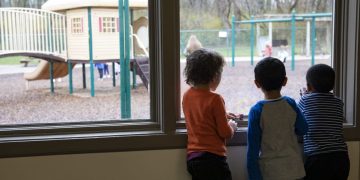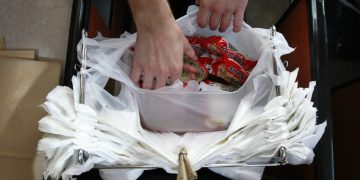6 ways to transform public education — minus the negative rhetoric
Public education is the great equalizer and a cornerstone of our democracy, and it has proven to be immensely successful. Yet, political rhetoric and constant talk about what’s broken with the system would have you believe otherwise.
The systems that are supposed to support public education have surely failed, creating chaos and cynicism in an era when we need public education more than ever. Outside influence is trying to make you believe that our public education systems are irrevocably broken; however, as with all systems, the key to success is through constant updates and revisions.
Our nation is working hard to adapt to social, cultural, technological, health, environmental and economic changes both at home and abroad. Public school models need to keep up with these shifts by listening to the voices in the classroom: teachers, administrators, staff and students. Systems that regulate and control public education must demonstrate flexibility, variability and a desire to adapt to the ever-changing world.
We need to reimagine education so that our children are prepared for these national and global changes — an effort that will take vision and collaboration, with educators leading the way. It will also take funding and sharing innovative practices, especially where we are currently carrying out extraordinary work. This means policy must be shaped by what the future holds, not by the past; instead of political dominance, we will need political flexibility and action.
I don’t claim to have all the answers, but as former president of the national School Superintendents Association, a current superintendent, an educator and a collaborator with years of experience working in private industry, I can share some invaluable insights — insights that have contributed to my own district’s success, have had a tremendous and positive impact on students, and are transferrable to other school systems.
Give all students access to industry exploration and future-driven opportunities as early as possible.
To truly explore the world of work, one needs to be exposed to the opportunities that are not only currently available, but those that might be part of our children’s future. Many students aspire to careers that require a college education. Others may prefer to seek technical careers.
For those who do plan on attending college, we can help them save money and earn college credits at the junior and senior levels of high school, through partnerships with community colleges and local universities. In our district, we offer “Academic Academies” that allow students to begin industry exploration across seven different paths through a combination of rigorous coursework, hands-on learning excursions in the form of Shadow Days and internships, and competitions related to the field. For instance, in our Education Academy, students not only gain experience through teaching students within our district, but in conjunction with Molloy University, they also can earn college credit.
Develop curriculum based on current and future job trends.
We know the healthcare and technology industries, though thriving, are experiencing significant job shortages that are only expected to worsen over the next decade. The healthcare sector is projected to grow 14 percent, adding 1.9 million jobs by 2028, as technology jobs are expected to increase by at least 12 percent, adding to the current gap of 1 million open jobs in the U.S. Designing a curriculum where students obtain hands-on experiences in these fields is what educators should focus on now. As an example, we offer a drone course, where students can receive their drone certification, because we recognize that the demand for drone pilots will continue to rise in various fields — from real estate and utilities to military and supply chain management.
Allow students to be producers and partners in their own future.
This means enabling students to create their own projects and educational paths and allow teachers to create learning opportunities where they might not be experts and to learn alongside their students. This allows them to challenge each other to expand their respective horizons through collaborations and partnerships.
For instance, one year, our students across all levels in the district wrote, designed and published a “coffee-table book” on the extensive history of their hometown, Baldwin. Our Better World Day initiative allows middle schoolers to work on a year-long multi-disciplinary research capstone centered around civic issues. As a result of this work, our children feel much more invested in their education, create more knowledge and understanding of concepts, and further their skills through such empowering experiences. Our teachers also see the increase in engagement and are motivated to dive even deeper into learning occurring inside and outside the classroom.
Encourage and accommodate adult learning.
Teachers and administrators should be involved in ongoing relevant professional learning and in developing the systems of the future. Teachers must be given the opportunity to understand and manipulate subject area content through the lens of the professions our students will one day call their careers. The future of work is complex and somewhat unpredictable; our educators should have the opportunity to be embedded in professions that utilize the skills necessary in their content areas. Math teachers can spend time with actuaries; English teachers can shadow a journalist; science teachers can work alongside an environmentalist. Teachers, more than ever, deserve these opportunities to expand their way of thinking for students and themselves.
Extend the classroom beyond its walls.
Students should partake in frequent experiential learning. Science should not be confined to the classroom; learning about nature and the environment should mean working in nature and the environment. Allow students to create a garden for their school or test local lake water under the direction of an environmentalist. Provide internship and externship opportunities to middle and high school students with local businesses and organizations focused on their areas of interest. This could mean shadowing a nurse at a hospital or participating in a police academy community training program. Offer virtual work-based learning experiences (one of the few unexpected positives of the pandemic is remote work), allowing students to partner with professionals nationwide.
Incorporate civics and media literacy into everything we do.
Our democracy relies on citizens recognizing and deciphering fact from fiction and taking an active role in their local and global communities. Ensuring these topics are embedded in the vital work educators do will ensure engagement and meaningful and relevant learning. It will develop our next generation of citizens with a healthy, knowledgeable and truthful understanding of the world around them.

Finally, we need to modernize the physical classroom and school facilities so students can be comfortable and grow in an environment that fosters creativity, communication, community, citizenship, collaborative learning and idea generation.
To move forward, let’s refocus our energy on broadening the country’s public education system for our children, putting politics aside and reimagining K-12 public schools on a clean canvas.
Shari Camhi, P.h.D., is the superintendent of Baldwin Union Free School District. She also serves as past-president of AASA, the national School Superintendents Association, and is an appointed member of the National Assessment Governing Board.
regular post copyright









